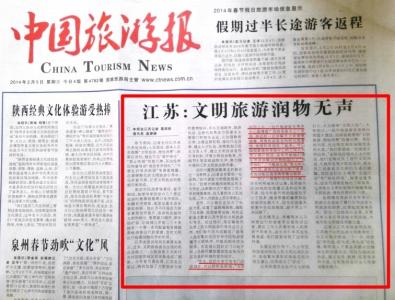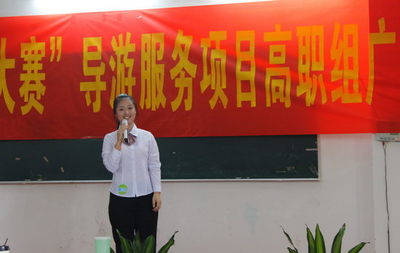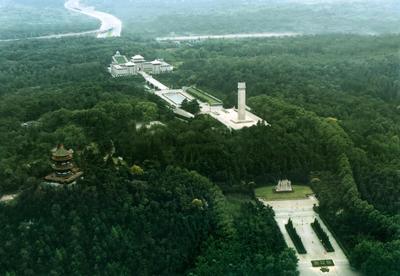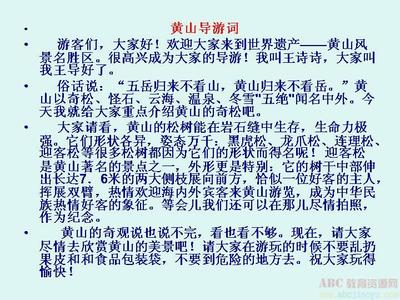说起中山陵,当然要提到它的主人--伟大的中国民-主革命先行者孙中山先生。下面是带来的中山陵中英文导游词,希望可以帮助到大家。
篇一:中山陵中英文导游词各位游客:在到达中山陵之前,先向大家简要地介绍一下孙中山先生的生平。孙中山,姓孙名文,字逸仙,在日本从事革命活动时曾化名“中山樵”。他于1866年11月12日生于广东省香山县翠亨村(现已改为中山市),是中国辛亥革命的领袖。孙中山早年曾求学海外,1892年毕业于香港西医学院,曾一度行医。20世纪初年的中国,灾难深重,清政府与帝国主义列强签订了丧权辱国的《辛丑条约》,使中国完全陷入半殖民地半封建社会的苦难深渊。目睹清政府的****,孙中山毅然放弃行医,投身革命,于1905年8月和一批资产阶级革命的知识分子,在日本东京组织成立了中国近代史上第一个带有资产阶级政党性质的组织“中国同盟会”,提出了“民族、民生、民权”即“三民主义”的革命纲领。从1907年到1911年10月前,同盟会在我国华南地区不断发动武装起义,特别是在1911年4月27日发动了广州起义。广州起义虽然最终遭到失败,但为同年10月10日的武昌起义取得胜利奠定了基础。从此各省纷纷响应,****了 2000多年的中国封建帝制,这就是中国近代史上影响深刻、意义深远的一次伟大革命——辛亥革命。
1911年12月29日,在中央临时政府会议上,大家一致推举孙中山为中华民国临时大总统,商议成立中国临时政府并定都南京,确定1912年为民国元年。1912年1月l日,孙中山从上海到南京就任临时大总统。但因袁世凯的扶持和革命党人的妥协,1912年4月1日,孙中山正式辞去临时大总统职,袁世凯窃取了革命果实,并定都北京。革命虽然受到挫折,但是孙中山先生没有气馁,继续展开了护法运动、护国运动、讨袁运动。1924年1月同中国共产党进行了第一次合作,并提出了“联俄、联共、扶助农工”的“新三民主义”。直到肝癌晚期,他仍忍着病痛,北上与冯玉祥商讨国事。1925年3月12日,终因肝病恶化在北京逝世。
孙中山先生生前十分喜欢钟山(紫金山)。早在1912年,就任临时大总统时,就曾登山游览。同年4月1日被解除大总统之职后,来这里打猎,看到这里山水相依,气势雄伟,就有了他回长眠此山的想法。在北京弥留之际,他还念念不忘这一夙愿,再三叮嘱左右。当然,孙中山葬于紫金山,不仅仅是个人的愿望,还有一个重要的原因,那就是南京曾是革命的策源地和临时政府所在地,孙中山先生长眠于此,表示了讨伐帝制和继续革命的决心。
为了尊重孙中山先生的遗愿,由孙夫人宋庆龄,儿子孙科等人组成的孙中山葬事筹备处,通过登报悬奖,征集陵墓设计方案。在众多的应征者中,年仅 33岁的青年建筑师吕彦直设计的警钟形图案被一致评为首奖。他本人也被聘主持全部工程。吕彦直是山东省东平县人,1894年生于天津。早年在清华大学建筑系毕业后,被公费派往美国康奈尔大学深造,得到美国著名设计师茂菲的指导,回国后,在上海开设“彦记建筑事务所”。为了设计南京中山陵和广州中山纪念堂,呕心沥血,不辞辛劳。在工程接近尾声时,身患肝癌,于1929年3月18日病逝,时年36岁。
Dear visitors: before reaching the sun yat-sen's mausoleum, begin by telling you a brief introduction of sun yat-sen's life. Sun yat-sen, named sun wen, word yat-sen, engaged in revolutionary activities in Japan once known as "zhongshan firewood". He was born on November 12, 1866 in xiangshan county of guangdong province tsui (now zhongshan city), is the leader of the revolution in China. Sun yat-sen once studied abroad in his early years, in 1892 graduated from the Hong Kong institute of medicine, was once to practice medicine. Of the 20 (superscript th) century China, disaster, the qing government to sign the country with the imperialist powers of the national treaty, making China into a semi-colonial and semi-feudal society completely suffering abyss. * * * * witnessed the qing government, sun yat-sen resolutely give up practicing medicine, devoted to the revolution, in August 1905 and a group of bourgeois revolutionary intellectuals, organization set up in Tokyo Japan in China's modern history the first organisation with a nature of bourgeois parties "Chinese brothers", put forward the "nation, the people's livelihood, civil rights," that is, "three people's principles" revolutionary programme. From 1907 to October 1907, brothers in our country continuously launch armed uprising in south China, especially in the April 27, 1911, launched the guangzhou uprising. Guangzhou uprising, though ultimately failed, for the same year on October 10, the wuchang uprising victory laid a foundation. From then on, the provinces have, * * * * for over 2000 years of Chinese feudal monarchy, the profound and far-reaching influence of China's modern history a great revolution, the revolution.
On December 29, 1911, in the central of the interim government meeting, everybody unanimously elected sun yat-sen as the provisional President of the republic of China, to discuss China's temporary government and east of nanjing, determined for the first year of the republic of China in 1912. On January l, 1912, sun yat-sen as temporary President from Shanghai to nanjing. But because of the support of yuan shikai and revolutionary compromises, on April 1, 1912, sun yat-sen as temporary President formally, yuan shikai steal revolutionary fruit, and its capital Beijing. Revolution despite setbacks, but sun yat-sen not discouraged, continue to expand the dharma, protecting movement, movement for yuan. In January 1924, the first cooperation with the communist party of China, and put forward the "united Russia, the communist party, the peasants" of the "new three people's principles". Until late liver cancer, he still endure pain, north and feng yuxiang to discuss affairs of state. On March 12, 1925, died in Beijing due to the deterioration of liver disease.
Sun yat-sen was very like to zhong shan (mountain). As early as in 1912, as temporary President, had been hiking tour. On April 1, the same year was discharged after the post of President, here hunting, see here landscape dependencies, magnificence, had his back to rest the idea of the mountain. Dying in Beijing, he also never forget this dream, urges. Sun yat-sen buried purple mountain, of course, is not just an individual desire, there is another important reason, is that nanjing was the birthplace of the revolution and the temporary seat of government, sun yat-sen reposing in this, said the crusade against the monarchy and the resolve to continue to revolution.
In order to respect the sun yat-sen's wishes by the lady soong ching ling, son sunke composed of people such as sun yat-sen was buried in Shanghai, by publicizing award, solicitation mausoleum design scheme. In numerous candidates, the age of 33, alarm bell shape design of young architects Lv Yanzhi design was awarded the first prize. He has been hired to host all project. Lv Yanzhi is dongping county of shandong province, was born in 1894 in tianjin. Early architecture in tsinghua university after graduation, has been sent at Cornell university in the United States, at public expense by American famous designer shigeru the guidance of the Philippines, back home, open "he architecture firm" in Shanghai. In order to design, sun yat-sen memorial hall, sun yat-sen's mausoleum in nanjing and guangzhou, and hard-working. In close to the end of the project, who is suffering from liver cancer, died on March 18, 1929, at the age of 36.
篇二:中山陵中英文导游词中山陵各位朋友,来到一座历史文化名城,你们一定想去看看当地最有名气、最具特色的景点吧。到了南京,如果没去中山陵,可以说你只看到了半个南京城。尽管南京素有"六朝古都"之称,拥有"金陵四十景"等众多名胜古迹,但中山陵无疑是其中最具吸引力、最有知名度的一个。
说起中山陵,当然要提到它的主人--伟大的中国民-主革命先行者孙中山先生。孙先生本名孙文,字逸仙。外国友人都称呼他为"孙逸仙博士"。因为他在日本从事革命活动时曾用过"中山樵"的化名,所以他在国内被尊称为孙中山先生。孙中山1866年11月12日出生于广东香山县(今中山市)翠亨村的一个农民家庭。他少有大志,先后求学于檀香山、香港等地,毕业后在广州、澳门等地行医。后来他弃医从政,并于1905年在日本组织中国同盟会,被推举为总理,提出了"驱除按虏,恢复中华,建立民-国,平均地权"的著名纲领,及"民族、民权、民生"的三民-主义学说。
1911年10月10日武昌起义爆发后,孙先生被十七省代表推举为中华民-国临时大总统,并于次年元旦在南京宣誓就职。此后,经历了"袁世凯窃国""二次革命""护国运动""护-法运动"等风风雨雨,1921年他在广州就任中华民-国非常大总统。在1924年1月广州召开的中国国民党第一次全国代表大会上,他将旧三民-主义发展为新三民-主义,提出了"联俄联共扶助农工"的三大政策。同年11月他应冯玉祥之邀抱病北上讨论国家大计,终因积劳成疾,于1925年3月12日在北京逝世。
中山陵的墓址是孙先生生前选定的。这里视野开阔,气象雄伟,的确是建造陵墓的好地方。你们也许会问;孙先生出生于广东,逝世在北京,毕生为革命奔波于各地,为什么要选择南京作为自己的长眠之地呢?
据说,早在1912年孙先生就任临时大总统时,灵谷寺的住持和尚就曾向他推荐过这块"前临平川,后拥青嶂"的风水宝地。当年3月31日,中山先生为求南北和平统一,毅然辞去总统之职。4月初的一天,他与胡汉民等人到明孝陵一带打猎,来到现陵墓所在地休息。孙先生环顾四周,对左右说,我将来死后,想向国民求得这块土地以安葬(待我他日辞世后,愿向国民乞一抔土以安置躯壳尔)。当然,紫金山的气势风水还不是孙先生作此决定的根本原因。孙先生临终前嘱咐:"吾死之后,可葬于南京紫金山麓,因南京为临时政府成立之地,所以不忘辛亥革命也。"因此,尽管孙先生在南京停留时间并不长,但南京对于孙先生是具有特殊意义的。他选择南京紫金山为墓址,从根本上说,是为了纪念辛亥革命,激励革命同仁。
Sun yat-sen's mausoleum friends, came to a famous historical and cultural city, you must want to see the most famous, the most distinctive local attractions. In nanjing, if did not go to sun yat-sen's mausoleum, say that you see only the half of nanjing. Although nanjing, long known as "the six dynasties ancient capital", has "jinling 40 landscape" and so on numerous scenic spots and historical sites, but sun yat-sen's mausoleum is undoubtedly one of the most attractive, one of the most famous.
Speaking of sun yat-sen's mausoleum, of course, must be mentioned in its master, the great national - the main revolutionary forerunner sun yat-sen. Mr. Sun name sun yat-sen,. Foreign friends all call him "Dr. Sun yat-sen". Because he is engaged in revolutionary activities in Japan when used pseudonym "zhongshan firewood", so he is regarded as sun yat-sen in China. Sun yat-sen was born on November 12, 1866 in xiangshan county (now zhongshan city) in guangdong province tsui a peasant family. He flew high and rare successively studied in Honolulu, Hong Kong and other places, to practice medicine in places such as guangzhou, Macao after graduation. Later he medical politics, and in Japan in 1905, the organization to China union, had been pushing for the prime minister, put forward the "drive out by lu, to restore the, the establishment of the people - the average land ownership" of the famous platform, and the "nation, civil rights, the people's livelihood" - the doctrine of three people.
On October 10, 1911 years after the outbreak of the wuchang uprising, Mr Sun was seventeen provinces represent pushing for the Chinese people - the temporary President, and the following year New Year's day was sworn into office in nanjing. Since then, has experienced the "yuan shikai mean" "second revolution" "nation sports" ups and downs, such as the "method of protection - movement in guangzhou in 1921, he became the Chinese people - the President very much. Chinese nationalist party (KMT) held in guangzhou in January 1924 the first national congress, he will be the old three people - development for the new three people -, put forward the "which was allied with Russia the peasants" of the three policy. In November the same year he came at the invitation of the feng yuxiang north discuss national plans, eventually because became ill because of overwork, died in Beijing on March 12, 1925.
Sun yat-sen's mausoleum burial site is Mr. Sun was selected. This vision, meteorological ambitious, indeed is a good place to build mausoleum. You may ask; Mr. Sun was born in guangdong, died in Beijing, all his life to travel around for the revolution, why choose nanjing as a final resting place?
It is said that as early as in 1912 as temporary President Mr. Sun, soul valley temple abbot monk is has been recommended to him the "would in the former, with green ailian" feng shui treasure. That year on March 31, Mr Zhongshan for the peaceful reunification, resolutely resigned from the presidency. One day in early April, his hunting around with hu and others to the Ming tomb, came to rest now tomb is located. Mr. Sun looked around and said to the left and right sides, after the death of my future want to the land to bury the national obtained (national begging for me after I died someday, to be a pile of soil in place for body). The purple mountain, of course, the momentum of feng shui is not Mr. Sun as the root cause of this decision. Mr Sun last asked: "after my death, can be buried in nanjing zijin foothills, for nanjing interim government was established, so don't forget the xinhai revolution." So, although Mr Sun in nanjing residence time is not long, but nanjing is has special significance for Mr. Sun. He chose nanjing purple mountain as a burial site, fundamentally speaking, is to commemorate the revolution, the revolution colleagues.
篇三:中山陵中英文导游词各位团友, 我们现在来到了南京紫金山的第二峰, 小茅山的南麓, 这里就是伟大的中国民主革命先行者孙中山先生的陵墓所在地—中山陵.
中山陵的墓址是孙中山先生生前所选定的. 1925年3月孙先生临终前, 他又嘱咐左右“吾死之后, 可葬于南京紫金山麓, 因南京为临时政府成立之地, 所以不忘辛亥革命也. ”
吕彦直所设计的中山陵, 平面为一“木铎”形, 形状如钟, 象征着中山先生精神如响亮钟声, 无远弗达, 这种设计也最符合先生遗嘱中“唤起民众”之意. 被“葬事筹备处”认为“简朴坚实且完全根据中国古代建筑精神”, 从而获“一致决定采用”, 陵墓在孙中山先生逝世一周年之际奠基, 1926年6月1日开工, 1929年春天完工.
Each group, we now come to the second peak of nanjing purple mountain, small maoshan foothill, here is the great pioneer of Chinese democratic revolution sun yat-sen's tomb is located - sun yat-sen's mausoleum.
Of sun yat-sen's mausoleum burial site was selected. Sun yat-sen alive in March 1925, Mr. Sun. Dying, he asked about "after my death, can be buried in nanjing zijin foothills, for nanjing interim government was established, so don't forget the xinhai revolution."
Lv Yanzhi designed by sun yat-sen's mausoleum, flat as a "MuDuo" form, shape such as clock, a symbol of the sun spirit, such as a loud bell, no far, this design is the most accord with "arouse people" meaning. In Mr Will be "buried in Shanghai" think "simple solid and completely according to the spirit of ancient Chinese architecture", to "unanimously decided to adopt", mausoleum first anniversary of the death of sun yat-sen founded on June 1, 1926, was completed in the spring of 1929.

 爱华网
爱华网


